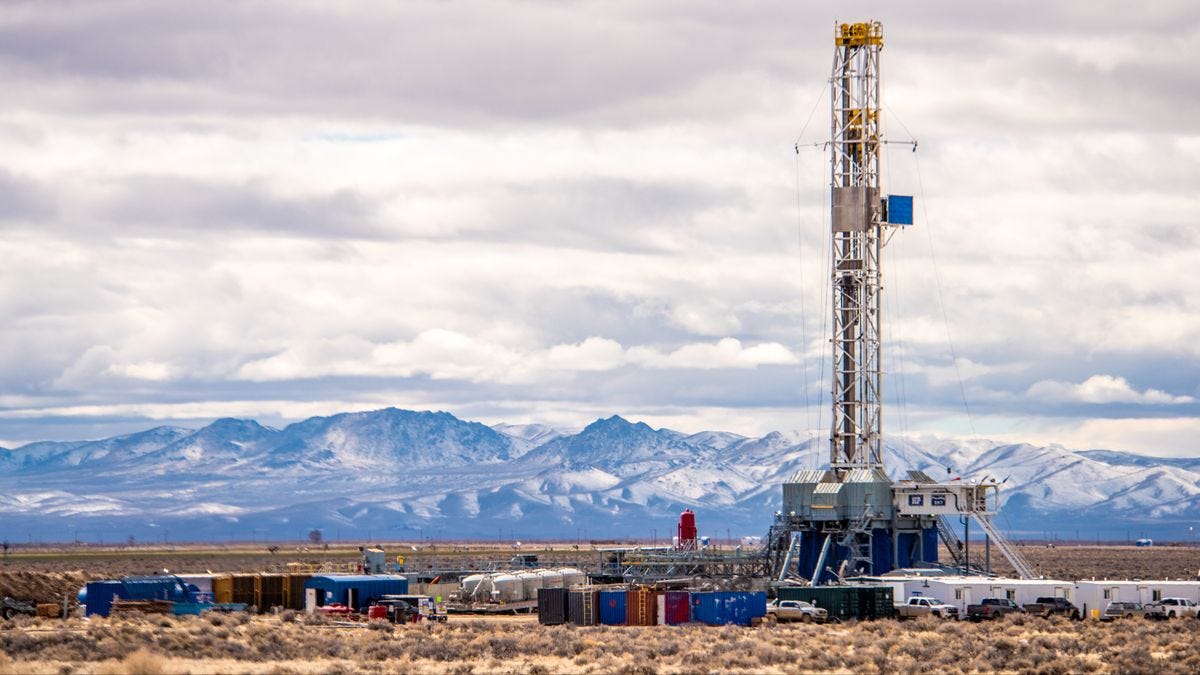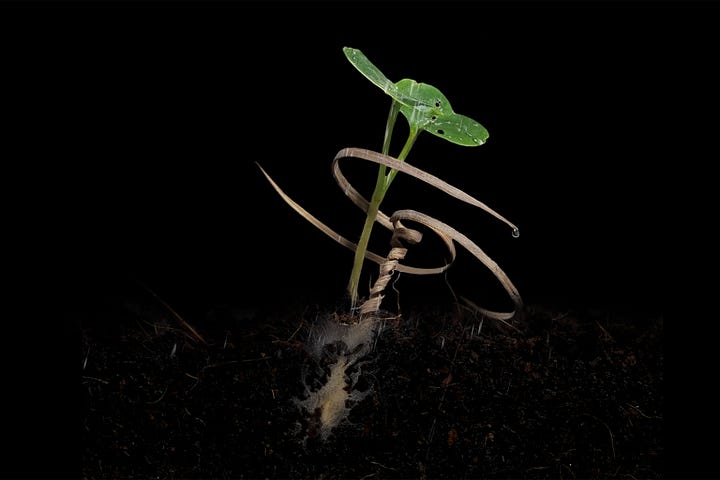The Weekly Anthropocene, July 26 2023
An epic breakthrough for enhanced geothermal, the rise of reforestation drones, a one-year report card for the Inflation Reduction Act, giraffe reintroduction in Angola, and more!
Enhanced Geothermal: Breakthrough!

For years, “enhanced geothermal” systems, or EGS technology, has been one of the great future hopes of the renewable energy field. Geothermal power is normally constrained by the availability of underground hot water deposits, which are common in some places, like Kenya and Iceland, but rare in most of the world’s land. EGS makes its own, injecting water far enough underground that it heats up, then letting that hot water rise back up another drilled well to turn a turbine to produce electricity. This offers a tantalizing vision of a holy-grail energy source: carbon emissions-free power obtainable anywhere in the world 24/7 without even the need for battery storage to ensure reliability1.
Now, a startup called Fervo Energy has made an impressive breakthrough, building and successfully testing the first commercial-scale EGS system! Their “Project Red” trial rig near Winnemucca, Nevada (pictured above) just wrapped up a 30-day test that successfully produced 3.5 megawatts of power. It should be connected to the grid and producing power (for Google’s Nevada data centers, incidentally) by the end of 2023. Notably, Fervo’s EGS rigs reuse a lot of drilling equipment from the oil and gas industry, which could potentially be extremely helpful in scaling this technology up fast. Instead of building up new solar panel, grid-scale battery, and wind turbine industries from scratch (which we’ve successfully done, but which took decades), the hopefully-nascent enhanced geothermal boom can just piggyback on all the oil and gas hardware, infrastructure, and expertise that we already have, and that will be needing new employment shortly.
Fervo has already started drilling for a much larger EGS project in Utah that they expect to generate 400 megawatts by 2028, should start on a 40-MW project elsewhere in Nevada in 2024, is at the permitting stage for several other Western US sites, and is in talks with several California utilities for potential future projects. This rapid commercialization and expansion is very promising-and exciting! As this writer hoped in a 2022 deep dive on geothermal energy, we are now indeed seeing the meteoric rise of another “miracle” clean energy technology, ready to join solar, wind, and batteries in decarbonizing the American grid and getting human civilization to stop burning things. Spectacular news!
Reforestation Drones


In the Anthropocene, mass tree-planting is urgently needed to help forests recover from wildfires, droughts, and other climate change impacts, as well as to sequester carbon and help address the root cause. As manual tree-planting is slow and laborious, a global wave of reforestation drone projects are emerging.
Companies, nonprofits, and universities around the world, including Carnegie Mellon University and Mast Reforestation in the United States, AirSeed in Australia, Flashforest in Canada, Seedcopter in India, Dronecoria in Spain, and Dendra Systems in the UK, are working to iron out the kinks in the idea of using unmanned aerial vehicles to plant seeds en masse. Key areas of innovation include linking drones into swarms to reduce the number of human pilots needed, customizing drop methods and times for different seeds’ biology, and creating soil and nutrient-filled capsules to surround dropped seeds, hopefully giving each one a hospitable microenvironment for growth. This is a fascinating emerging field, and as engineering challenges are overcome, reforestation drones could become a great help for Earth’s biosphere within a few years!
Low-Lignin Trees
A research team from North Carolina State University used CRISPR gene editing to breed poplar trees with lower levels of lignin, a tough structural polymer that gives wood much of its “toughness.” Greenhouse tests found that some edited tree lineages had up to 50% less lignin. This is useful because removing lignin from wood is one of the most energy-intensive steps in creating soft products from wood pulp, from common paper to the emerging field of wood-based insulation2. If low-lignin trees can be used in paper-making at scale, it would make the process substantially more efficient, creating less “black liquor,” (a paper-making by-product full of lignin residues) and reducing greenhouse gas emissions by up to 20%3! Great work.
United States
A new report from renowned research firm Rhodium Group assesses the impact of the Inflation Reduction Act, almost one year after its original passage. They found that the IRA subsidies have already made solar power about 40% cheaper and wind power about 55% cheaper in the United States, and are on track to make greenhouse gas emissions decline substantially faster than previously expected. The Rhodium Group estimated before the IRA was passed that U.S. greenhouse gas emissions would decline 26 to 41 percent below 2005 levels by 2035, and now estimates that emissions will decline 32 to 51 below 2005 levels by 2035. This amounts to a “meaningful departure from previous years’ expectations for the U.S. emissions trajectory” [in a good way]. Strong progress!
For decades, the oil and gas industry has gotten a free lunch from American taxpayers, leasing federal land for drilling at far below market prices. The minimum 12.5% royalty rate that oil companies have to pay for use of the land has remained unchanged for over one hundred years, making it effectively a substantial fossil fuel subsidy. Biden’s Interior Department is now reforming that leasing system, raising the minimum royalty rate to 16.7% and prioritizing renewables development on federal lands over new fossil fuel development, alongside other common-sense changes.
Even as climate change causes more floods, droughts, and other extreme weather, crop yields in the United States remain high, boosted by improved crop breeding and precision agriculture techniques (often supported by USDA research and grants). For example, corn yields hit a record high of 11.09 tonnes per hectare in 2021, up from 8.59 in 2000 and 1.76 in 1900, and only declined very slightly to 10.88 tonnes per hectare in 2022, despite having to endure unusually heavy rains in spring and prolonged drought in summer across much of the Midwest. Yields are even increasing relative to fertilizer inputs (i.e. farming is getting more efficient) and total U.S. farm output is outpacing population growth. Great news!
A major utility in Michigan accelerated its plans to transition to clean energy. DTE Energy announced that it will close its last coal plant (a 3,400 megawatt facility) in 2032, three years ahead of schedule, while building up 15 gigawatts (15,000 megawatts) of renewable energy and 1,800 megawatts of energy storage by 2042. Another local example of the renewables revolution!
Angola
Due to a decades-long civil war, giraffes went locally extinct in Angola sometime in the mid-1990s. A few private landowners have since brought them back, but they remained absent from the country’s national parks. Now, 14 young giraffes from Namibia have been reintroduced to Angola’s Iona National Park, in what is planned to be the first of many such translocations to reestablish a robust Angolan giraffe population.
The multi-group effort was spearheaded by African Parks, a renowned conservation NGO that has contracted to manage Iona National Park for the Angolan government. African Parks has brought about a small revolution in African wildlife conservation with its unique model of offering to run national parks as a “subcontractor” for the local government in exchange for being given management authority. It’s a win-win, as African Parks hands over park revenues to the governments while funding themselves through international donations. African Parks now runs 19 national parks in 11 African countries, and is leading rapidly improving conservation outcomes across the continent. The return of giraffes to Angola is just the latest success of this fascinating endeavor.
Check out The Weekly Anthropocene’s deep dive into geothermal energy for more background!
The Weekly Anthropocene: Geothermal Energy
The Background: Failure to Launch Back when this writer was a wee lad, learning about renewable energy in the first decade of the 21st century, it was often described as a triad of technologies: solar, wind, and geothermal. Today, you’re much more likely to hear “wind and solar”, or perhaps “wind, water, and solar (WWS)” to include hydropower. Why is this?
This is the kind of eye-catching innovation that is often met with suspicion, especially given that it uses gene editing, a longstanding lightning rod for anti-science fearmongering. However, genetically modified organisms are overwhelmingly safe and useful: over 90% of currently grown corn, cotton, and soybeans in the U.S. are genetically modified and it’s caused no serious problems.







You guys are going to hate me!! I'm a member of the Oregon Natural Desert Association and I think there's some concern over here about drilling impacts on our desert especially the McDermott lithium exploration and the geothermal exploration to the west. Renewables are great! Wind, solar, hydro, geothermal. All are positive! But they come at costs. Rewilding us stymied. Even the tire tracks of exploration vehicles last for hundreds of years. Drilling through shallow pressurised aquifers can lead to loss of springs and small ponds that support endangered wildlife. Ash Meadows Wildlife refuge in Nevada is in danger of that from nearby drilling. It's all part of the industrialization of the wild landscape. Wind power is wonderful until you see what happened to the Columbia River gorge east of the protected area. All to support a bunch of large cities and urbanites with their lattes!
Don't hate on me too much..
--desert rat Michael
Go geothermal!